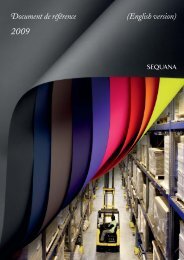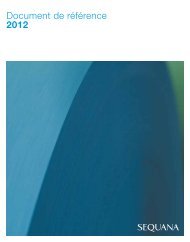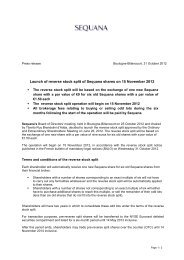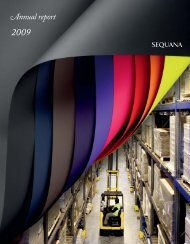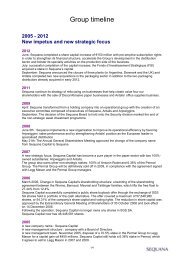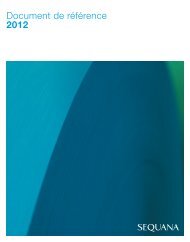Contents
Registration document PDF - Sequana
Registration document PDF - Sequana
Create successful ePaper yourself
Turn your PDF publications into a flip-book with our unique Google optimized e-Paper software.
1Presentation of the groupPresentation of SequanaLeveraging innovation to cement leadershipInnovation is a vital part of the sales strategy pursued byArjowiggins’ divisions, which all have their own research anddevelopment teams.To anticipate and meet consumers’ needs, each R&D departmentworks closely with operational teams in order to develop new,highly innovative products. Partnerships developed with outsideresearch institutes and laboratories help transfer fixed costs outof the Group and provide access to highly specialised resources.Arjowiggins’ divisions put innovation at the centre of their strategy,helping to forge powerful brands and giving them a real edgein their respective markets. These innovation efforts continued in2012, resulting in the launch of various new products includingPowercoat paper for printed electronic applications and DiamoneXtra highly resistant paper used for banknotes.Research and development expenses totalled €12 million in 2012,or 0.8% of sales (2011: €11.7 million).Arjowiggins – Results and strategy2012 highlights■■Production model optimised and capacity adjusted in line withdemand, with the closure of three plants.■■Product innovation efforts stepped up.Improved operating performance2012 witnessed a slump in volumes of printing and writingpapers in Europe, North America and in the creative papers segmentcoupled with strong downward pressure on selling prices.However, specialty businesses remained buoyant, particularlythe security solutions and medical/hospital activities. Sales weredown by 3.2% on 2011 to €1,419 million (down 5.4% at constantexchange rates).Arjowiggins benefited from the drop in raw material prices overthe year. Waste paper prices fell sharply and the price of pulp wasbelow its 2011 levels but remained higher than expected. Cottonprices also fell back to near-2010 levels. The cost of energy andchemical products remained high. The fall in raw material pricesalong with an improved product mix for specialty businesses andcost savings helped Arjowiggins offset the volume downturn.EBITDA came in at €64 million, up 29.2% year-on-year, andrepresented 4.5% of sales.Recurring operating income came in at €14 million compared to€22 million in 2011 (which included a gain of €17 million arisingon pension funds in the UK, with no impact on EBITDA).Operating margin came in 0.5 points lower at 1% of sales.Optimisation of production modelIn the face of structural decline and overcapacity in the marketfor printing and writing papers, Arjowiggins is constantly adaptingits production capacity in line with demand. In August, itclosed a paper machine at its Chartham plant in the UK. Thedeteriorating economic environment during the summer acceleratedthe decline in volumes, and the company decided to shutdown three further plants to optimise efficiency and reduce costs.The Witcel plant in Argentina and Dalum Papir A/S plant inDenmark closed in the second half of 2012. Together with themachine shut down at Chartham, this represents a total capacityof 114,000 tonnes (including 103,000 tonnes for Dalum PapirA/S). Closure of the Ivybridge plant in the UK with a capacityof 14,000 tonnes should be effective in the first quarter of 2014.These measures will reduce Arjowiggins’ total production capacityby around 10%, making it easier to manage and improve plantefficiency and achieve a capacity utilisation rate of above 90%.Thanks to the flexibility of its production facilities, all productranges were able to be transferred to the company’s other sites inFrance, the UK and Brazil.Key figures(€ millions) 2012 20112010managementpro formaSales 1,419 1,465 1,489EBITDA 64 50 112Recurring operating income 14 22 (1) 66Operating margin 1.0% 1.5%Cash flow from operating activities 55 43 45Capital employed 357 472 561 (2)Recurring operating income/Capital employed (ROCE) 3.9% 4.8% 13.6% (2)Net debt 275 313 353 (2)(1) Including gains of €17 million arising on changes to pension plans in the UK (unallocated to divisional operating income). Adjusted for these items, recurring operatingincome amounted to €5 million instead of €22 million and operating margin came in at 0.3% instead of 1.5%.(2) 2010 published data.34 | Sequana | 2012 Document de référence (English version)



